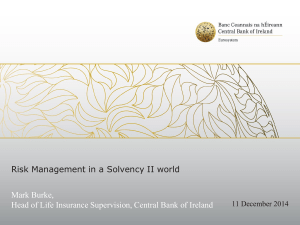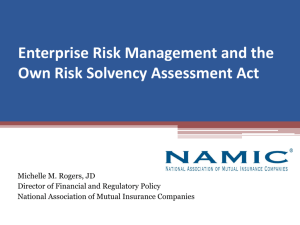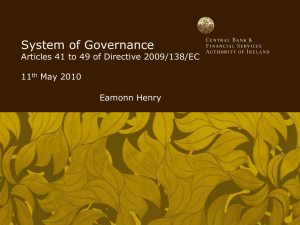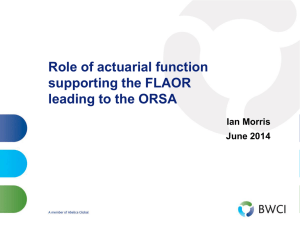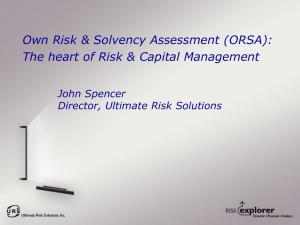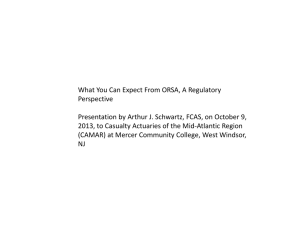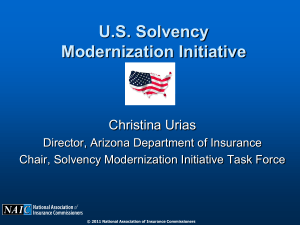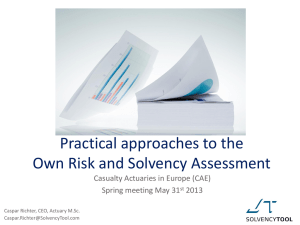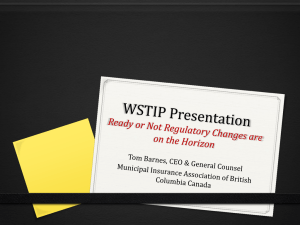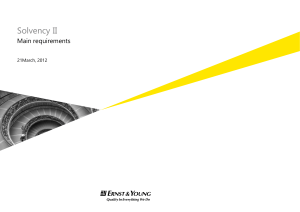Own Risk Solvency Assessment (ORSA)
advertisement
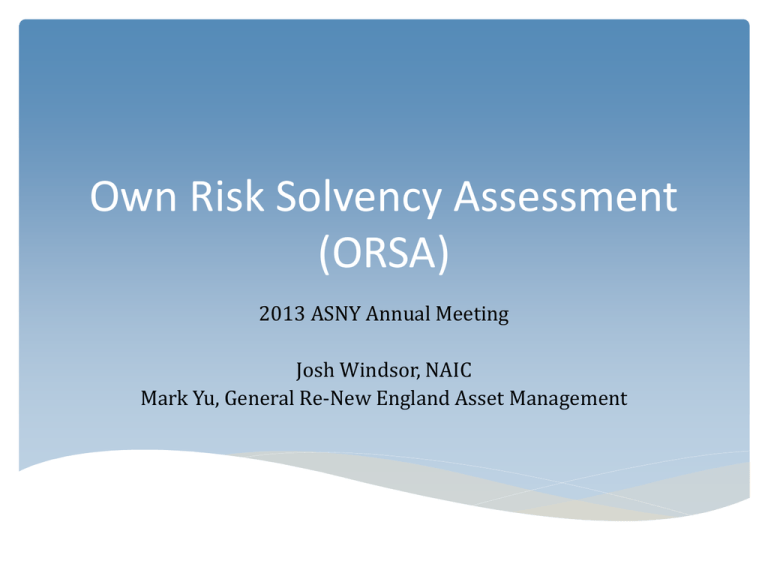
Own Risk Solvency Assessment (ORSA) 2013 ASNY Annual Meeting Josh Windsor, NAIC Mark Yu, General Re-New England Asset Management Today’s ORSA discussion is presented by: Josh Windsor Mr. Windsor recently joined the national Association of Insurance Commissioners (“NAIC”) after nearly 20 years insurance related experience. He is a member of the NAIC’s financial regulatory affairs international and market surveillance unit where he will work on a variety of national and international projects. He was previously associated with a consulting firm that serves regulators with a variety of projects including risk focused examination of insurance companies, risk assessment and capital requirements for various insurance entities. Josh is a Fellow of the Society of Actuaries, Fellow of the Institute and Faculty of Actuaries, a member of the American Academy of Actuaries and the Secretary of the Actuarial Society of New York. Mark M. Yu Mr. Yu joined GR-NEAM in 2012 as an Enterprise Risk Management professional focusing on the capital management and corporate development activities for Life insurance companies. Prior to joining GR-NEAM, Mr. Yu was a senior risk manager within the Governance and Strategy team at AIG Enterprise Risk Management. Prior to working at AIG ERM, he was a Senior Vice President and Treasury Director within the Group Capital Management division of Swiss Re. Mr. Yu holds a B.A. from National Tsing Hua University in Taiwan and a M.S. from the University of Iowa. He is a Fellow of the Society of Actuaries, a CFA charter holder, a Financial Risk Manager, and a Member of the American Academy of Actuaries. The views presented by the speakers are as individual professionals and are not the opinion of their employers or of the Actuarial Society of New York. 2 Table of Contents A. ORSA OVERVIEW B. ASSET RISK EVALUATION – METHODOLOGY & APPROACH C. ASSET RISK EVALUATION – SAMPLE ANALYTICS AND REPORTING D. Parting Remarks 3 Own Risk and Solvency Assessment Overview (ORSA) What is ORSA? It is an own-risk review with the following key questions: What is our strategy? What level of risk are we willing to assume in pursuit of this strategy? What are the key risks that could hinder our ability to achieve our strategy? How much capital do we need to cover those key risks? What risks – individually or collectively- would subject us to losses that exceed our tolerance? What risk scenarios would cause us to fail or stop operating as a going concern? 5 ORSA - Key Points Building a bridge between risks, capital needs and available capital. [Note the distinction between capital needs and RBC requirements] Elevated risk awareness Improve risk governance processes and techniques Evolving by nature (business mix, environment factors, best practices) ORSA will lead insurer management teams to be much more deliberate and explicit in how they identify measure and manage enterprise risks 6 ORSA - Key Points (Cont’d) A robust ORSA addresses current and prospective risk in five key categories: Underwriting Credit Market Operational Liquidity 7 Solvency Modernization Initiative NAIC Own Risk and Solvency Assessment Background • Solvency Modernization Initiative (SMI) adopted by the NAIC in 2008 to respond to financial crisis and international regulatory solvency developments • Risk Management and Own Risk and Solvency Assessment (ORSA) Model Act adopted in September 2012 with effective date of January 2015 • ORSA Guidance Manual to provide guidance regarding the reporting of insurer’s own risk and solvency assessment • ORSA not required for Individual insurers with annual gross premium (“AGP”)< $500 million and/or Insurance groups with AGP of less < $1000 million Capital Requirements Governance & Risk Management Solvency Modernization Initiative Group Supervision Statutory Accounting & Financial Reporting Reinsurance 8 Timeline The NAIC launched the Solvency Modernization Initiative (SMI), a critical “self-examination” to update the U.S. insurance solvency regulation framework. No fundamental revision of the regulatory capital formula (called Risk Based Capital) but only revision to include CAT and Operational Risk. Also introduction on Principle Based Reserving for life companies. Two new formats of statutory reporting have already been approved by the NAIC as part of the SMI: • Form F Enterprise Risk Report (ERR) – in effect from 2013 in some states (see article in the Fall 2013 Examiner magazine). • ORSA Summary Report – in effect from 2015. ORSA and Form F Timeline NAIC ORSA Guidance Manual Nov. 2011 ORSA Model Act adopted on Sept 12, 2012 NAIC ORSA Model Act proposed effective date Jan. 1, 2015 2nd ORSA Pilot 1st ORSA Pilot (June-July 2012) (May-Sept 2013) 2010 2011 2012 2013 2014 2015 First Form F reporting for some states (July 1, 2013) NAIC 2010 Model Law (Form F on ERR) 9 The main building blocks of the NAIC ORSA Implementing the NAIC ORSA can be structured around segmented building blocks, each with its own principles. The following represents an illustrative building block model that has been developed for ORSA. Section 1 Section 2 Risk management framework Assessment of Risk Exposures Risk culture and governance structures Risk identification and categorization Quantitative risk assessment / economic capital modelling Board of Directors oversight Risk prioritization and assessment tools Qualitative risk assessment Risk policies, procedures, and programs Risk monitoring methods and controls Stress testing methodologies and documentation Risk appetite, tolerances and limits Risk reporting and communication Model validation and calibration Evaluation and feedback loop 10 Section 3 Group risk capital and prospective solvency assessment Group risk capital adequacy determination, approaches and assessment Integrating capital management into decision-making (“Use Test”) Capital forecasting and prospective solvency assessment Own Risk and Solvency Assessment Overview ORSA’s Two Key Requirements: The ORSA is a process The ORSA report is a regulatory filing • ORSA is an insurer’s own process for assessing its risk profile and the capital required to support its business plans in normal and stressed environments on a forward-looking basis • On an annual basis, insurers will be required to provide a regulatory filing that explains their ORSA process and results • The filing does not have a prescribed format but should at the present time contain 3 sections: 1) description of ERM framework; 2) assessment of risk exposures; and 3) group risk capital and prospective solvency assessment • The Guidance Manual requires insurers/insurance groups to carry out this risk and solvency assessment process on a regular basis ► NAIC ORSA involves a self-assessment of the insurer’s risk management framework and solvency position 11 NAIC Own Risk and Solvency Assessment Filing Requirements (1/3) 1. Description of ERM Framework • High level summary of key ERM elements • Identification and assessment of relevant and material risks for executed business strategy • Documentation of assessment tools • Description of accounting basis and legal entity structure • Definition of critical risk management policies and procedures Source: North America CRO council presentation 12 Typical Enterprise Risks (not consistent with Official ORSA Guidance) 13 NAIC Own Risk and Solvency Assessment Filing Requirements (2/3) 2. Assessment of Risk Exposures Market Risk • Relevant and material risks • Qualitative vs. Quantitative • Normal vs. Stressed scenarios • Tolerance and limits • ……. • Both quantitative and qualitative assessments • Under normal and stressed environments • Model validation, calibration and assumption setting process • Methodology and approach • Multiple perspectives including regulatory, economic and rating agency, etc • Tolerances and limits setting process Credit Risk Insurance Risk Operational Risk ….. 14 NAIC Own Risk and Solvency Assessment Filing Requirements (3/3) 3. Group Risk Capital and Prospective Solvency Assessment Normal Environment Stressed Environment • Group level “available” capital versus “risk” capital evaluation • Intra-group transactions, debt leverage and diversification benefits • One to three years forward-looking solvency assessment • Link business strategy and capital actions to prospective assessment • Different tolerances at different confidence levels under different valuation bases Risk Tolerance Time 15 NAIC Own Risk and Solvency Assessment ORSA vs. Statutory Risk-Based Capital (RBC) US Statutory RBC (Ongoing) NAIC ORSA (1/1/2015*) Focus Factor based and meant to identify weakly capitalized companies Emphasize process and both qualitative and quantitative Perspective Backward looking; historical data based Forward looking with stressed scenarios considerations Considerations No consideration of business plan and strategy Incorporate business plan and corporate capital actions Entities All regulated insurance entity Subject to minimal gross premium threshold Approach Prescriptive; factor based Non-prescriptive; own & discretionary View Individual legal entity view Aggregated group level approach Capital Requirement Specific thresholds for regulatory actions triggers None but meant to address “target” capitalization level *Filing date: states might set a filing date; the NAIC has discussed allowing companies to submit around their business processes, but some states might require these to be submitted once a year at a particular time 16 Recent Developments As of August 5, 2013, five States have adopted Model Reg 505: RI, IA, NH, ME and VT. It is under active consideration in 8 more (see map following). The American Academy of Actuaries has a working party that is preparing a model ORSA report for regulators. Another (2013) round of ORSA testing by the NAIC. 17 Recent Developments (Cont.) 18 Deficiencies in the 2012 ORSA Pilot Study addressed by the NAIC (Absent Items) Reports did not always specify the accounting approach used (e.g., GAAP, SAP, IFRS) The organizational and legal structures were not always clearly explained A comparison of material changes over time A comparative look back for three years Legal entity mapping Glossary of terms used by the company 19 Deficiencies in the 2012 ORSA Testing by the NAIC (Absent Items Cont.) Detailed explanation of the company’s risk limits, including key risks and materiality Combined stress test scenarios in addition to the single stress tests Descriptions and explanations of tables and graphs Details on capital model calculations Risk owner assignment 20 Deficiencies in the 2012 ORSA Testing by the NAIC (Absent Items Cont.) Compensation and incentive linkage to risk, including how this is determined by the company Heat maps of risks Graphical comparison of different capital models if mentioned or used Executive summary Stronger, more detailed prospective risk sections 21 Asset Risk Evaluation – Methodology and Approach Prudent Model Assumption: Normal vs. Asymmetric The world is usually not normal • Assumptions of normality translate into misleading results • It is essential to maintain a broad understanding of the risk characteristics of the portfolio • Risk analysis and evaluation should capture and understand the impact of asymmetry on a portfolio’s risk / return profile * Asymmetric, Non-Normal Returns VaR / T-VaR Prospective Returns & Vols Enterprise Decision 0.02 *4P = four parameters, where normal skewness = 0.0; normal tail = 2.0 23 Source: GR-NEAM Analytics Identify Model Consequences Tail Risk Evaluation: Multiple Approaches with Various Implications Downside Risk Metrics VaR Value-at-Risk T-VaR Tail Value-at-Risk • Maximum Loss Not Exceeded With a Certain Probability • Expected Loss if Loss Event Occurs End-of-Period Intra-Period “At any time within the period” Measures may be Expressed: At Multiple Confidence Intervals Multiple Periods: Daily, Weekly, Monthly, Quarterly, Annually Statistical Distribution Normal Market Conditions Extreme Tail Risk • Standard Normal, • Diffusion Process, • Levy with alpha-Stable As Portfolio or Capital Loss • Neglecting Extreme • Allows For Jumps High Degree of Customization End-of-Period: SNEOP Intra-Period: DIP Methodology, Heavy Tailed Market Movements 24 Source: GR-NEAM Analytics Value-at-Risk and Tail Value-at-Risk : Traditional Measures with an End-of-Period View Portfolio Annual Returns Value-at-Risk (VaR) Defined The amount of loss not to be exceeded with a certain probability in a given time frame; typically expressed as a percent of capital Tail Value-at-Risk (T-VaR) Defined The expected amount of loss if the VaR loss threshold is exceeded Hypothetical 99.0 VAR ~ similar in concept to a 1-in-100 year event Hypothetical 99.5 VAR ~ similar in concept to a 1-in-200 year event Hypothetical 99.6 VAR ~ similar in concept to a 1-in-250 year event 25 Source: GR-NEAM Analytics Intra-Period Losses May Be Significant And Require Advanced Techniques To Avoid Pitfalls of Traditional VaR & T-VaR Metrics Portfolio Annual Returns Intra-Period vs. End-of-Period Traditional VaR/T-VaR methods underestimate Intra-period VaR/T-VaR estimation approach Intra-period downside risk by focusing on end-of- reflects realistic downside risk. (E.g. -19.7%) period return distributions Solely. (E.g. -1.6% annual portfolio return) 26 Source: GR-NEAM Analytics Asymmetric Measures Capture Extreme Events When Markets Are Not Normal: Compare Annual T-VaR @ 6.1% vs. 13.8% 27 Source: GR-NEAM Analytics Asset Risk Evaluation – Sample Analytics and Reporting Multi Portfolio VaR (T-VaR) Evaluation Multi-portfolio, multi-currency, multi-time-period views with consideration of hedge effects 29 Source: GR-NEAM Analytics Multi Portfolio VaR (T-VaR) Migration What-if downside risk analysis under different market cycles, assumptions and approaches 30 Source: GR-NEAM Analytics Incremental VaR (T-VaR) Analysis Asset’s downside risk contribution within portfolio context; portfolio downside risk impact from (proposed) changes in asset allocation 31 Source: GR-NEAM Analytics VaR Risk Decomposition Portfolio Risk Factor Decomposition 250 $19.9 99.5 VaR ($MM) 200 $27.4 $139.1 $45.8 150 $32.2 100 $93.7 50 $84.6 $36.9 0 Currency Equity Interest Rate Structure Credit Implicit Correlation Risk Correlation (Diversification) Provides insight into portfolios’ downside risk drivers Addresses regulatory / rating agency risk management expectations 32 Source: GR-NEAM Analytics 99.5 VaR Asset Return Forecast – Benchmark Comparison Prospective benchmarking and expected tracking error; Estimate potential prospective losses by asset class or risk factor 33 Source: GR-NEAM Analytics Stress Test: Historical Relevance Compare and contrast statistical risk results with historical stress events outcome 34 Source: GR-NEAM Analytics 2012 Life Industry Asset Return vs. T-VaR Distribution Asset TRR vs. 99.5% T-VaR (Excl. Affiliated Equities) (Intersect @ Industry Median) Annualized Total Return 8.0% 7.0% 6.0% 5.0% 4.0% 3.0% 0% 2% 4% 6% 8% 10% 12% 14% 99.5% T-VaR (Invested Assets) 35 Source: GR-NEAM Analytics 16% 18% 20% Parting Remarks Parting Remarks (not NAIC advice) 1. Tail risk evaluations should address non-normal and asymmetric characteristics 2. Intra-period evaluations are equally, if not more than end-of-period results 3. What-if analysis and benchmarking offer valuable insight for contemplated actions 4. Risk analytics and reporting need to provide actionable information 5. Relating statistical results to historical scenarios adds additional context and story 37 Today’s ORSA discussion was presented by: Josh Windsor Mr. Windsor recently joined the national Association of Insurance Commissioners (“NAIC”) after nearly 20 years insurance related experience. He is a member of the NAIC’s financial regulatory affairs international and market surveillance unit where he will work on a variety of national and international projects. Mark M. Yu Mr. Yu joined GR-NEAM in 2012 as an Enterprise Risk Management professional focusing on the capital management and corporate development activities for Life insurance companies. Prior to joining GR-NEAM, Mr. Yu was a senior risk manager within the Governance and Strategy team at AIG Enterprise Risk Management. Prior to working at AIG ERM, he was a Senior Vice President and Treasury Director within the Group Capital Management division of Swiss Re. Mr. Yu holds a B.A. from National Tsing Hua University in Taiwan and a M.S. from the University of Iowa. He was previously associated with a consulting firm that serves regulators with a variety of projects including risk focused examination of insurance companies, risk assessment and capital requirements for various insurance entities. Josh is a Fellow of the Society of Actuaries, Fellow of the Institute and Faculty of Actuaries a member of the American Academy of Actuaries and the Secretary of the Actuarial Society of New York. JWindsor@naic.org 212 -398-9000 He is a Fellow of the Society of Actuaries, a CFA charter holder, a Financial Risk Manager, and a Member of the American Academy of Actuaries. Mark.Yu@grneam.com 860-676-8722 The views presented by the speakers are as individual professionals and are not the opinion of their employers or of the Actuarial Society of New York. 38 Questions? 39
